Author: Mandy Barth
Billy, the lineman’s “assistant”
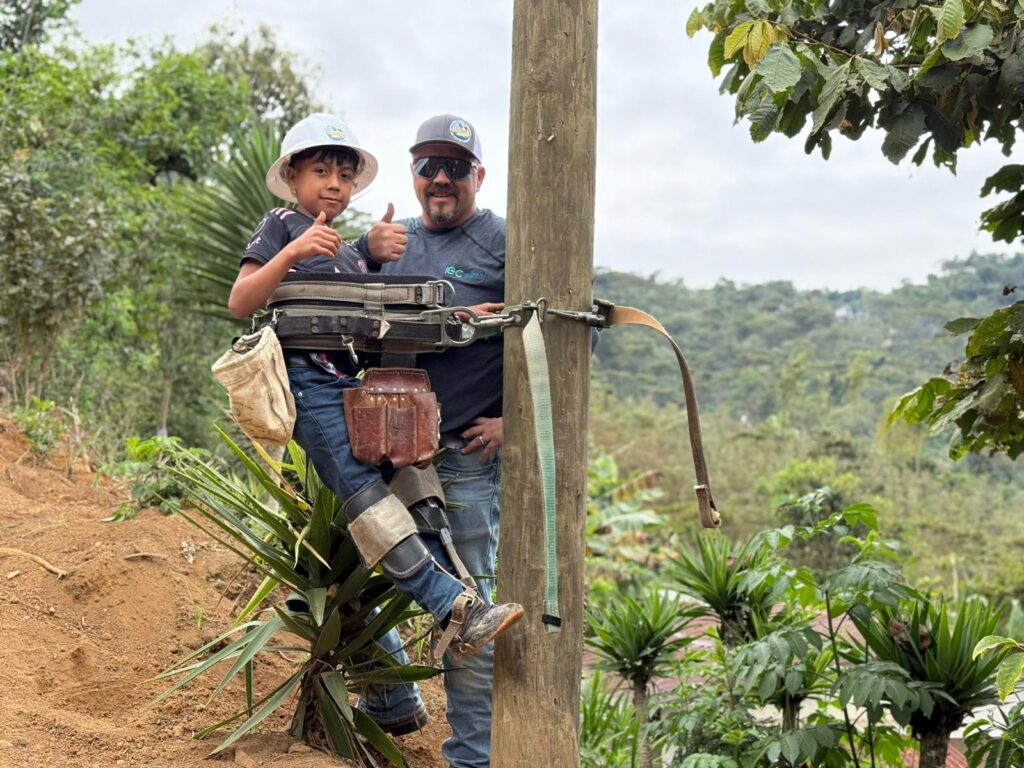
The project crew is providing each of the 109 homes with two outlets, three overhead lights, and three light switches. At one of the first homes they wired, they encountered a young boy named Billy. Although a language barrier exists, he greeted each new friend with a smile, a fist bump and “Hi, I’m Billy!”
Ten-year-old Billy watched intently as the linemen wired his home, where he lives with his family, which includes two brothers and two half-sisters. As the linemen prepared to move on to wire the next home, they found Billy tagging along. He quickly became a great assistant, grabbing a tool, holding a ladder, fetching a part — whatever the crew needed. And he’s tagged along to each home they’ve wired since. He’s become their little assistant.
The school in the village of Palmira has one teacher. To accommodate the learning needs of the different levels, they rotate the students in 2-3 week increments, with 1-2 grade levels attending at a time. As fate would have it, Billy’s grade level isn’t in session right now.
So, Billy greets the crews when they arrive early each morning and follows them throughout the day. He just wants to be a part of it – he just wants to help. He can take pride in knowing he has played a part in making the future of his community brighter. And, maybe Billy has a future as a cooperative lineman?
And, the linemen he’s worked with on this project will certainly leave a piece of their hearts with him when they return home.
Travel, tackling challenges and the trust of a better tomorrow
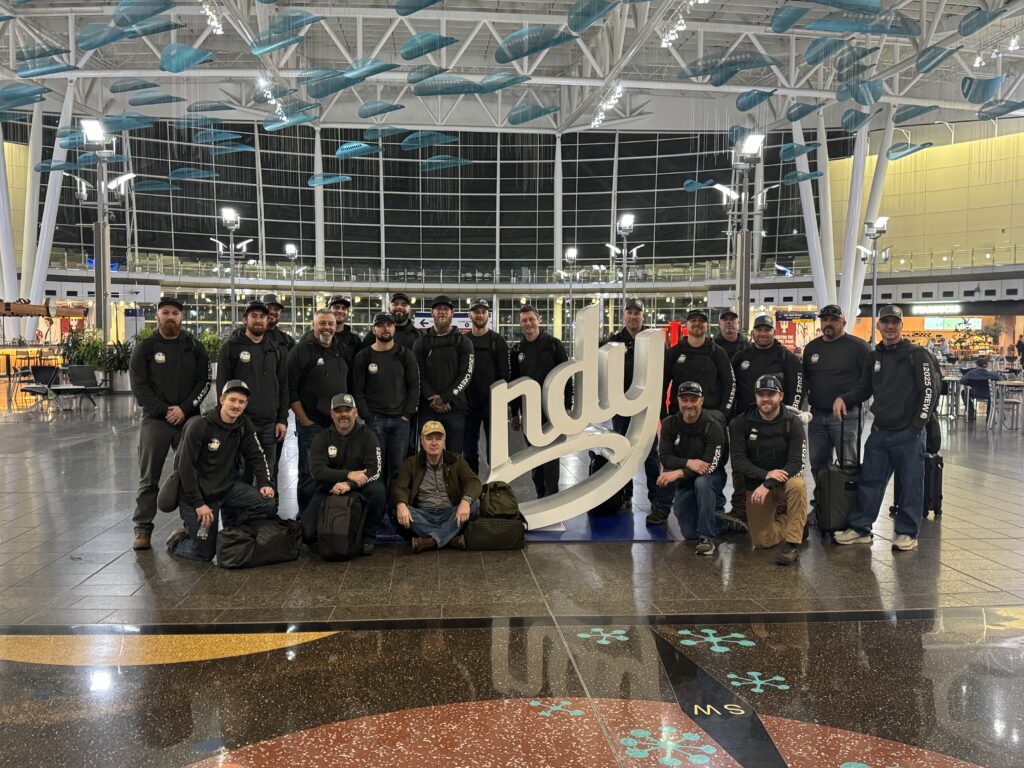
Since leaving Indianapolis this week, the Project Indiana crew has experienced long travel days, has tackled challenges placed before them, and experienced the trust the Palmira families have placed in them for the hope of a better tomorrow.
The first travel day of any project trip is always a long one, and this trip was the same. The project crew left Indianapolis Wednesday, Jan. 29, at about 6:45 a.m., and finished the day when they arrived at the Hotel Fuente Real in Huehuetenango, Guatemala, at about 1 a.m. [But, before taking off from Indy, JCREMC’s Kevin Bay snuck in an interview!]
After a good night of sleep and a good breakfast, they stopped at a convenience store to stock up on water, Gatorade and sodas – and then hit the road to finish their drive up the mountain. They settled in at their home for the next two weeks – a hotel that’s about a 35-minute drive from the project village of Palmira.
They arrived in the village mid-afternoon Thursday to get oriented and sort supplies, so they could start the ground running Friday morning. This included organizing their supply “warehouse” and getting their wire reels set.
Their plan is to start each day with breakfast at 6:30 at a restaurant that’s about a 10-minute drive from their hotel. With their bellies full, they’ll head to the village to work until around 6 each day. The plan for Friday’s work is to start pulling spans of wire and to start wiring the homes.
Friday’s work started off slower than hoped. Although used for our 2023 project build, the racks that hold the large reels of wire couldn’t withstand the weight of the reels and they broke. Doing what linemen do best, they improvised and adapted to come up with a solution. The crew ended up pulling about four spans of line and started hanging it on poles. The inside wiring crew members were able to get about 10 homes wired today.
The plan for Saturday is to pull secondary wire through the coffee fields that surround the village. The inside wiring crews will continue their work, and are expected to gain momentum as they wire each home.
The heartwarming scene of the day: four or five pickup trucks pulling into the village with refrigerators and electric stoves loaded in the bed. The modern conveniences we take for granted are about to become a reality for the families of Palmira. They’ve placed their trust in the Project Indiana linemen — gentlemen they’ve not met before Thursday. But, gentlemen with whom they’ve placed their trust of a better tomorrow.
Celebrating light.
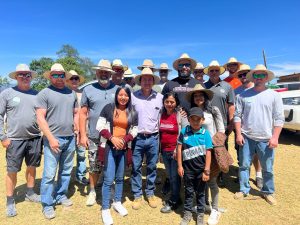
There was cause for celebration in Pena Roja this week. Just as it has been on each of the four Project Indiana construction trips before this one, our linemen brought electricity to a village that has never had it before. That was the mission. But, as they’ve done on each trip before this one, the linemen celebrated with the villagers a successful mission and the possibilities that are to come for those who live in Pena Roja.
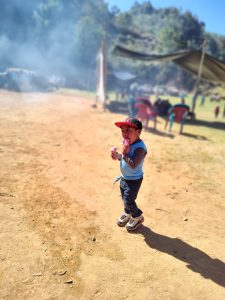
The village residents dressed in their Sunday best and prepared a feast for all who were there to celebrate this much-anticipated time with them. And, there was ICE CREAM, a rare treat that wasn’t possible before the linemen brought electricity to power freezers. They offered a festive environment with music and dance. Dignitaries celebrated with a ribbon-cutting ceremony.
Their neighbors came from near and far to celebrate the light and possibilities now available to the residents of Pena Roja. The nearby village of Las Flores was electrified by Alabama’s electric cooperatives in 2013. They joined in the celebration this week, too. The schoolchildren from Las Flores came to celebrate with their Pena Roja friends and to extend their appreciation to their electric cooperative friends.
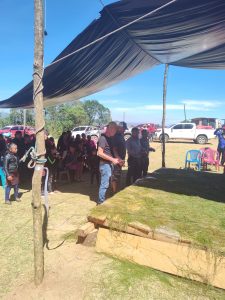
And, the Project Indiana team celebrated alongside their new friends from Pena Roja.
A few from the team had quietly made a “short” trip to the community of Cuilco to do a little shopping for gifts. After pooling their money, the team returned with 65 pair of shoes, 65 coloring books, four soccer balls, pinatas, fireworks and some backpacks. Each Pena Roja child received a new pair of shoes and a coloring book. The men offered a cornhole-contest-of-sorts to give away the backpacks. They played soccer with the children, and celebrated the festive day with the fireworks and pinatas.
By the time the Project Indiana team left the mountain at the end of that day, every home in Pena Roja had working electricity. This was truly a day to celebrate.
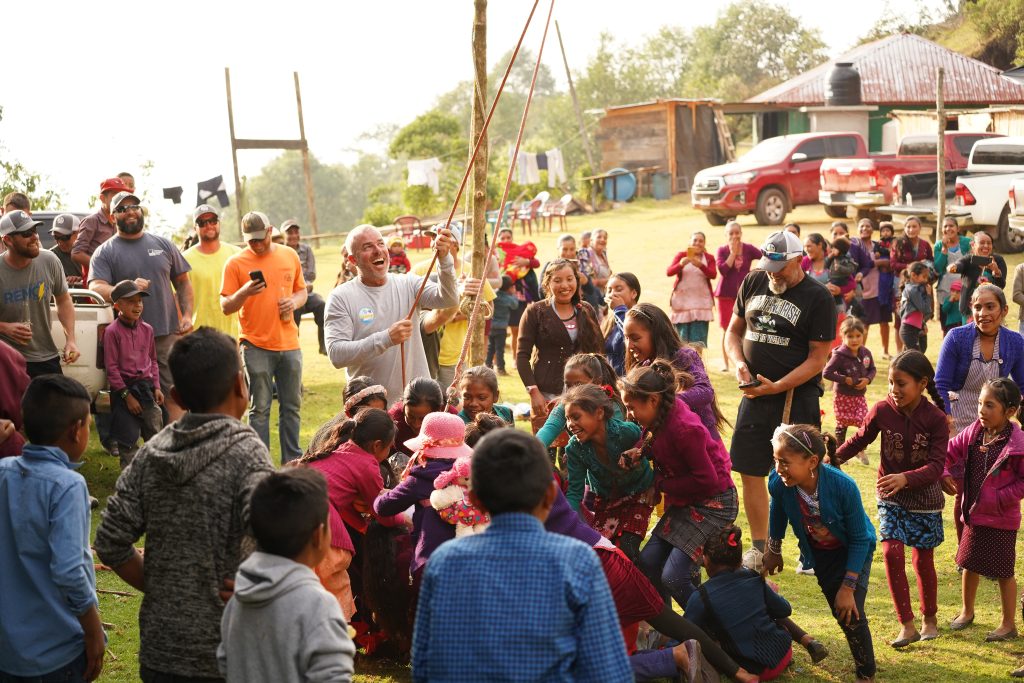
Picture Day.
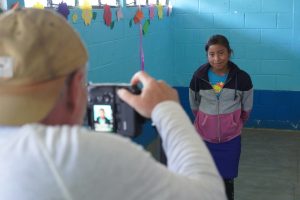
School and family pictures are something we take for granted here. Most American schoolchildren have a school picture day at least once a year. Many families coordinate their outfits for a family photo to adorn the front of the annual holiday card. But, in Guatemala, portraits are a luxury.
Because of this, Project Indiana support team member Ron Holcomb makes it a personal mission to host a picture day on every trip he takes to Guatemala. By day, he’s the CEO of Linden, Indiana-based Tipmont. However, his personal passion is capturing images of the people of this land he’s come to love through Project Indiana.
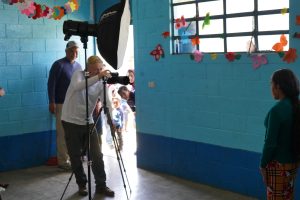
On each trip to the remote areas of Guatemala, Holcomb takes the equipment needed to host a picture day for all who are able to come. The village school usually offers a central gathering spot. “Everybody within a couple of miles is here it seems like,” said Chris Todd, marketing director at Northeastern REMC and the volunteer documenter of the Pena Roja project trip.
Those who live in these remote villages have rarely, if ever, seen images of themselves in a photograph. On this trip, Ron brought with him prints of the photos he took on his last trip to the region.
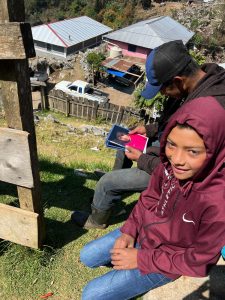
Imagine the emotion of seeing a photograph of your child for the first time. Or, having a photo of a parent to look back on many years from now. It’s the little things we take for granted. The purpose of this trip was to bring electricity, but the photographs are one more little thing we can offer.
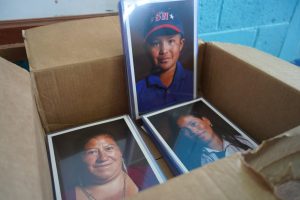
There is light!
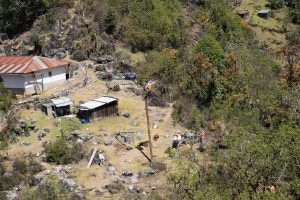
Wednesday and Thursday were beautiful days on the mountain. Following a night of heavy rain, the sun came out very early Wednesday and helped dry everything out. Wednesday night the team watched a very bright thunderstorm across the mountain ridge to the west of the village. However, that storm didn’t bring any rain to Pena Roja that night.
Half of the village homes had electricity turned on Wednesday and the other half were turned on Thursday. This includes the widow who lives near the end of the line and the very hard-working older gentleman who has been heating water each day for the project team to take showers with. When the crew came down at the end of the day and informed him his dirt-floor home had power, he could not control his emotions.
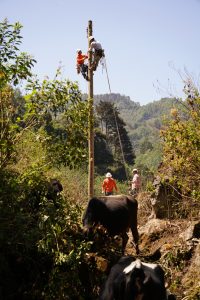
There is still some work to do at the school to get that area back on. Friday, they plan to visit the Monumento area near the Mexican border to complete maintenance on a three-pole section. They will be taking a pole with them to that location. The views from this region are breathtaking. We expect Friday’s photos to be even more amazing.
Fortunately, rain has not impacted the crew’s progress to this point. The mountain roads in this area are rarely paved and are mostly dirt roads. When rainfall is significant, it makes not only the roads treacherous, it also makes the terrain difficult to navigate on foot. A couple of additional days were included in the trip’s schedule to accommodate rain delays.
There remain four homes that need the inside wiring completed. The team will also strive to get that project done before they leave the village.
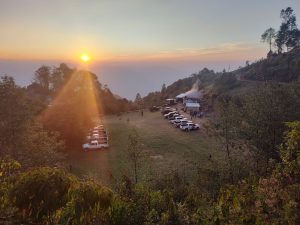
The project team also noticed the villagers moving a chest freezer into one of the homes at which power had been turned on. The villagers have been anticipating this time for so very long and they were anxious to begin using modern appliances. This freezer will enable them to preserve things like meat so they can have a regular protein in their diets.
The project team is holding up well. They anticipated the terrain and elevation of at least 11,000 ft. to make this project challenging. Sore knees, backs and blisters have been a part of the adjustment, but the crew is taking it in stride like linemen do – they adapt and overcome!
A Broken Record
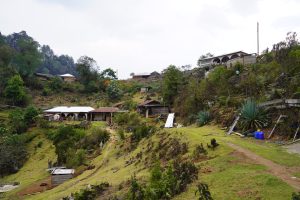
It seems like each daily update has become a broken record, but it was another beautiful and productive day! The weather was perfect yet again and allowed the project team to accomplish a lot.
At the end of today, the team has just seven spans each of triplex and duplex wire to pull to be at a point of electrifying all of the homes in the village. However, they need some additional guy wire to finish that part of the project. They expect that guy wire to be delivered to the village overnight.
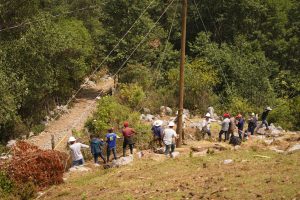
The team also anticipates having about a day and a half of work to complete at the school to increase the reliability at that location.
They are currently planning to tackle the maintenance work near the Mexican/Guatemalan border on Friday, assuming all continues to go well this week.
They are getting some significant rainfall in the village overnight, and that may significantly slow the pace of the work. The terrain of the village is tough, and the rain will make navigating it even more difficult.
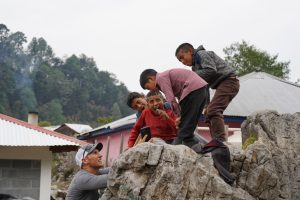
The village residents have been working right alongside our project team throughout this build. They understand how impactful electricity will be for them, and are with our team every step of the way. And, although there’s a language barrier, the village children are taking it all in. Their smiles demonstrate their interest in this life-changing time in their lives.
Another Amazing Day

The Project Indiana team had another amazing day on the mountain. The weather cleared up, the sun shone, and the temperature was in the 80s.
The ladies in the village did the team’s laundry and hung it out to dry this morning.
The crew hung another 11 spans of wire. Because of the terrain, the spans are ranging from 350-ft. to approximately 1,100-ft. For context, the average span in the U.S. is approximately 300 ft. The crew also hung the second transformer and dug some additional anchor holes today.

The crew also started some work around the village school, which already has a power source. However, the current line runs through some vegetation, which causes power outages. The crew will be moving the line to avoid the trees and, ultimately, avoid power outages they cause during storms.
The remainder of the triplex line was also delivered to the village today.
Project Indiana board member Ron Holcomb participated in a meeting of the local cooperative’s board.
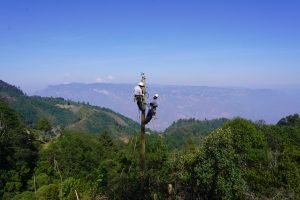
And, a couple of members of the crew scouted some maintenance work on existing lines. The potential work is very near the Mexican/Guatemalan border and about an hour from Pena Roja. If the project team is able to finish the Pena Roja project in enough time, they will assist the local cooperative with some necessary maintenance.
The terrain is rough compared to what they’re used to in Indiana, specifically walking up and down the mountain many times a day – making for some sore toes and feet. At the end of the day, the team reports that they are loving the experience and are looking forward to future opportunities in Guatemala.
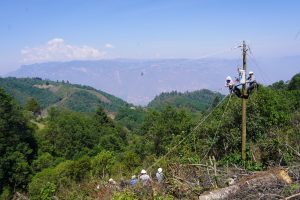
A productive day
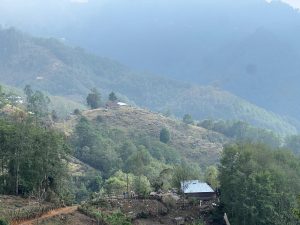
The project team was anxious to get to work, and they sure were productive today!
They spent their first night in the village last night, where it rained all night and the temperature hit about 60 degrees F. The crew started the day with a hot breakfast of eggs and beans, and a review of the day’s plans.
After breakfast, they loaded the trucks with supplies and headed out to begin pulling wire. Throughout the day, the crew pulled all of the wire they had on site and only have about four spans left to pull. Additional wire will be delivered to the village Monday.
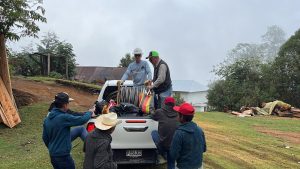
This project incorporates two transformers, one of which is on a pole at the peak of the mountain at about 12,000 ft. That transformer was hung today as well.
Once all of the available wire was hung, the crew started hanging wire on poles. The crew got wire hung on approximately seven poles, with approximately three spans completely in the air.
The weather throughout the day was 75-80 degrees F and cloudy, but the sun made an appearance shortly before dinner. They’re expecting rain again overnight.
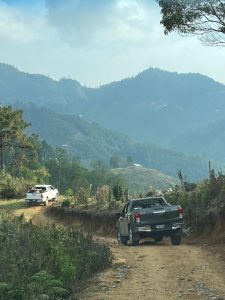
The team concluded the day feeling good about all they’d been able to accomplish in a short time. The hot showers and a hot meal were appreciated after a long and productive day.
The Container Arrives!
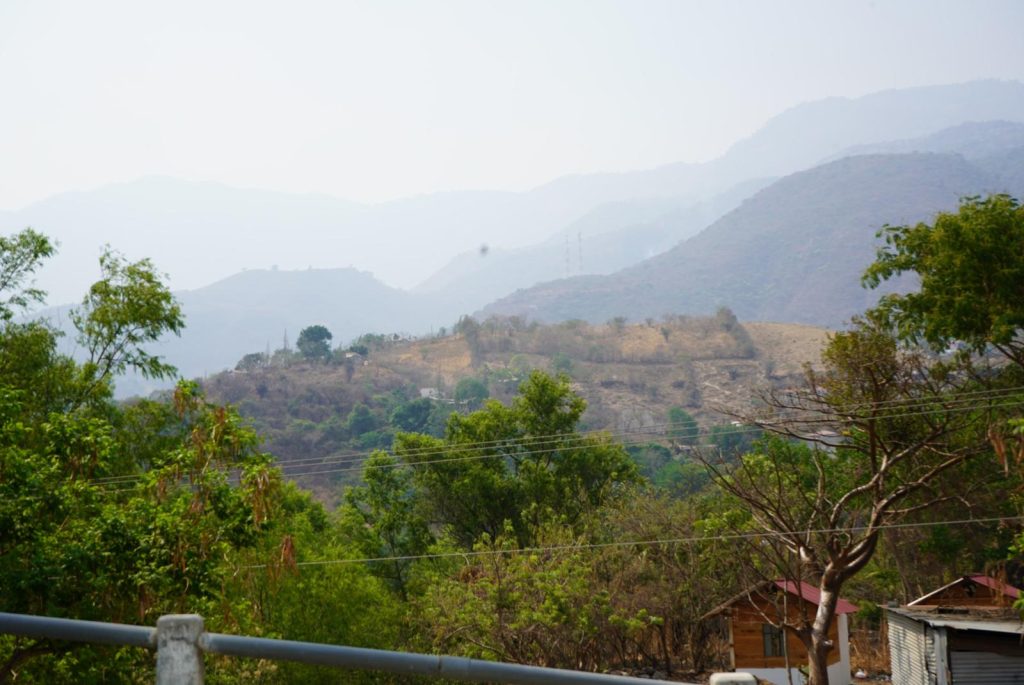
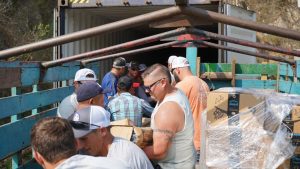
And, the crew finally arrived in Pena Roja! The long-awaited shipping container with supplies caught up to the Project Indiana team in Huehuetenango this morning, which allowed the crew to complete its journey to the project site in Pena Roja, Guatemala.
The semi-truck with the shipping container arrived in Huehuetenango by mid-morning. The project team quickly got to work unloading the container onto smaller trucks for the rest of the trip up the mountain. The roads beyond Huehue are more primitive and generally unpaved, which makes them unable to reliably sustain a vehicle as heavy as a semi-truck. Distributing the supplies among several smaller vehicles made the rest of the trip possible.
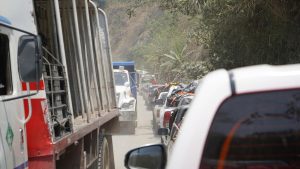
Before departing Huehuetenango, several team members shopped for the perishable groceries they’ll need in the village. A cook accompanied the crew to the village and will prepare meals for them while they’re on the mountain. The coolers packed on the shipping container were needed to ensure a safe trip up the mountain.
They encountered more Guatemalan traffic on this leg of the trip, some of which is captured in the photo album for today.
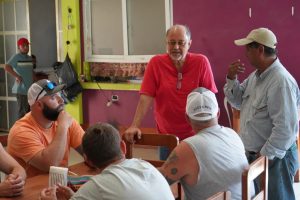
The crew stopped in the village of Cuilco for lunch and to refuel. The town’s mayor joined the crew for lunch.
After a brief stop, they continued on their way and reached Pena Roja this evening. They will spend the remainder of the evening unloading the trucks and getting settled before resting for the night.
The crew is anxious to get to work! They anticipate they’ll be able to begin pulling wire first thing in the morning.
Fourteen lineworkers to empower a global community for a better tomorrow
Fourteen Indiana electric cooperative lineworkers will travel to Guatemala in late April as part of an international initiative to bring electricity to a developing area in Guatemala.
“Project Indiana: Empowering Global Communities for a Better Tomorrow” will bring electricity to a part of the Central American country where none is available. The crew will spend April 27 through May 13 extending electric infrastructure in the village of Peña Roja along the western edge of Guatemala. When completed, approximately 26 homes will have electricity for the first time.
Project Crew
- Matt Bassett, Tipmont
- Kevin Bay, JCREMC
- Michael Bowman, Boone REMC
- Cody Campbell, South Central Indiana REMC
- Nathan Clayton, Clark County REMC
- Collin Crabtree, Decatur County REMC
- Ethan DeWitt, Northeastern REMC
- Austin Gearlds, NineStar Connect
- Tom Gettinger, Henry County REMC
- Clint Heeke, Southern Indiana Power
- Frank Leach, Carroll White REMC
- Terry Minic, Paulding Putnam Electric Cooperative, Inc.
- Jason Morrison, Jackson County REMC
- Michael Newlin, Orange County REMC
Support Team
- Joe Banfield, Indiana Electric Cooperatives
- Jamie Bell, NineStar Connect
- Ron Holcomb, Tipmont
- Chris Todd, Northeastern REMC
This is the Indiana electric cooperatives’ fifth trip to Guatemala. In August 2012, 28 Hoosier lineworkers from 17 of Indiana’s electric cooperatives, spent four weeks working across the mountainous terrain to bring electricity to 184 homes, a church and a school in three villages. In April 2015, 14 lineworkers battled extreme heat and the rugged land to bring electricity to 164 homes, a school and a church.
In 2017, 14 lineworkers endured temperature extremes to power 68 homes, a school, a church and a health clinic. And, on the last trip in 2019, 14 lineworkers brought electricity to nearly 90 homes, two churches and a school, and ensured that every home they wired for electricity had a properly vented wood-burning cooking stove installed to replace the open fires villagers have used for years.
Follow along the crew’s journey in Peña Roja by visiting ProjectIndiana.org/PenaRoja.
